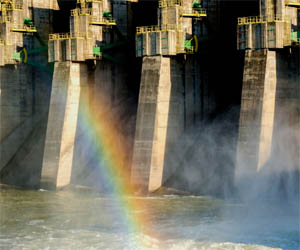



Dreams, those mysterious landscapes of the mind, have captivated human curiosity for centuries. They are a realm where reality blurs with the surreal, where the boundaries of time, space, and logic seem to vanish. Within this enigmatic realm, a plethora of dream phenomena occurs, and exploring these phenomena can offer profound insights into the human psyche and the nature of consciousness.
Lucid Dreaming: One of the most intriguing dream phenomena is lucid dreaming, where the dreamer becomes aware that they are within a dream. This heightened state of awareness allows individuals to take control of their dreams, shaping them according to their desires. Lucid dreamers can fly, converse with dream characters, and explore landscapes limited only by their imagination.
Nightmares: Nightmares are distressing dreams that can be intense and vivid. They often evoke feelings of fear, anxiety, or helplessness. These dreams can provide a window into one's fears and unresolved traumas, serving as a natural outlet for processing emotional turmoil.
Recurring Dreams: Some individuals experience recurring dreams where the same themes, scenarios, or even specific characters reappear. These dreams may be a subconscious attempt to grapple with persistent issues, providing an opportunity for self-reflection and problem-solving.
Premonitions: Some people claim to have dreamt of events before they occurred, a phenomenon known as precognitive dreaming. While the scientific validity of these claims remains a subject of debate, many believe these dreams to be glimpses of the future.
Sleep Paralysis: Sleep paralysis is a frightening phenomenon in which individuals wake up from a dream, unable to move, and may experience hallucinations or a sense of impending doom. It occurs as one transitions between sleep and wakefulness and is often linked to a disrupted sleep cycle.
Déjà Vu: Déjà vu is the feeling that a current experience has been previously encountered in a dream. This intriguing phenomenon has been the subject of much speculation and has sparked questions about the relationship between dreams and reality.
False Memories: Dreams have the power to create false memories. People may vividly recall events from their dreams as if they were real, blurring the lines between dream and waking life.
Out-Of-Body Experiences (OBEs): Some individuals report having dreams where they view their own bodies from an external perspective. These experiences can be both profound and disorienting, challenging our understanding of consciousness and self.
Epic Dreams: Epic dreams are those that seem to unfold over extended periods, sometimes covering the span of a lifetime within a single dream. These dreams can be rich with symbolism and often leave a lasting impact on the dreamer's waking life.
Telepathic Dreams: Some people claim to have dreamt of events or communicated with others telepathically during their dreams. The scientific explanation for such occurrences remains elusive, but they continue to intrigue and baffle researchers.
Dream phenomena remain a vast and largely uncharted territory within the realm of human consciousness. While science continues to explore the mechanisms behind dreams and their various manifestations, dreamers themselves are the true pioneers, delving into the depths of their own subconscious minds to uncover the secrets hidden within these ethereal experiences. The world of dreams is a place where the ordinary becomes extraordinary, and where the mind's greatest mysteries are waiting to be unraveled.


 One of the key quatrains cited as evidence of Nostradamus' insight into climate change is Quatrain 75 from Century 5, which states:
One of the key quatrains cited as evidence of Nostradamus' insight into climate change is Quatrain 75 from Century 5, which states:
"The reign will be very old by lunar years
In the year of the great seventh number done:
Appearing at the time of the great games of slaughter:
Not far from the age of the great millennium
When the dead will come out of their graves."
Proponents of the idea that Nostradamus predicted climate change suggest that this quatrain alludes to an era when the consequences of environmental neglect and climate-related disasters will become undeniable. They interpret the "reign very old by lunar years" as a reference to the long duration of human existence and the environmental damage caused over time. The "great seventh number" could signify a climactic shift or a significant change in the planet's equilibrium due to human actions.
In Quatrain 17 from Century 1, Nostradamus wrote:
"For forty years the rainbow will not be seen.
For forty years it will be seen every day.
The dry earth will grow more parched,
And there will be great floods when it is seen."
Some interpreters argue that this quatrain reflects the irregular and extreme weather patterns associated with climate change.






A Comprehensive Guide To A Happy And Healthy Feline Friend
 4. Grooming And Hygiene
4. Grooming And Hygiene
Grooming is an essential part of cat care. Regular brushing prevents matting and reduces shedding. Some breeds may require more frequent grooming. Pay attention to your cat's claws and provide scratching posts to maintain their claws.
5. Hydration
Proper hydration is vital for cat well-being. Ensure your cat has access to fresh, clean water at all times. Some cats prefer running water, so a cat water fountain can be a good investment.
6. Mental And Physical Stimulation
Cats need mental and physical stimulation to remain happy and healthy. Provide toys, scratching posts, and interactive playtime to keep your cat engaged and prevent boredom. These activities also allow your cat to exercise their natural instincts.
7. Safe Environment
Creating a safe and comfortable environment is crucial for your cat's well-being. Remove potential hazards, keep toxic plants and chemicals out of reach, and offer stimulating objects and areas for exploration.
 Positive Reinforcement
Positive Reinforcement
Positive reinforcement is a cornerstone of effective dog training. This technique involves rewarding your dog with treats, praise, or affection when they exhibit the desired behavior. By associating good behavior with positive outcomes, your dog is more likely to repeat those actions. Consistency in providing rewards and timely reinforcement is key to success.
Clicker Training
Clicker training is a precise and efficient method that pairs a distinct sound (the click) with a reward. Dogs quickly learn to associate the click with good behavior and become more responsive to training cues. Clicker training allows for clear communication and is especially useful for teaching complex tricks and commands.
Obedience Training
Obedience training is a structured approach to teaching your dog essential commands like sit, stay, and come. This technique establishes a foundation for good behavior and ensures your dog's safety in various situations. It is essential to practice obedience commands regularly to reinforce your dog's understanding.
Consistency
Consistency is a vital element in dog training. Use the same commands and cues consistently, so your dog can easily understand what you expect from them. Everyone in your household should be on the same page regarding training techniques and reinforcement to avoid confusing your dog.
Socialization
Socialization is critical for puppies and older dogs alike. Exposing your dog to different people, animals, and environments helps them develop into well-adjusted pets. Socialization can reduce fear and aggression while improving overall behavior and adaptability.
Paving The Way For A Sustainable Future
 Renewable Energy Technologies: One of the most notable areas of green technology advancement is in renewable energy sources. Solar power, for instance, has witnessed tremendous growth, thanks to advancements in photovoltaic technology and the development of more efficient solar panels. Wind turbines have become increasingly effective, both in onshore and offshore applications. The integration of these technologies into the energy grid has paved the way for a cleaner and more sustainable energy future.
Renewable Energy Technologies: One of the most notable areas of green technology advancement is in renewable energy sources. Solar power, for instance, has witnessed tremendous growth, thanks to advancements in photovoltaic technology and the development of more efficient solar panels. Wind turbines have become increasingly effective, both in onshore and offshore applications. The integration of these technologies into the energy grid has paved the way for a cleaner and more sustainable energy future.
Energy Storage Solutions: Advancements in energy storage technologies are essential to overcoming the intermittency of renewable energy sources like wind and solar. Energy storage systems, including batteries and other innovative technologies, help store excess energy for use during periods of high demand or when renewable energy sources are not generating electricity.
Electric Vehicles (EVs): Green technology advancements have transformed the automotive industry. Electric vehicles (EVs) have become more affordable and accessible, with improved battery technologies leading to longer driving ranges and faster charging times. These EVs help reduce greenhouse gas emissions from the transportation sector.
Smart Grids: The development of smart grids is another noteworthy green technology advancement. Smart grids enhance the efficiency and reliability of energy distribution by integrating digital communication and control technologies.
Unveiling The Enigmatic Connection

Hypnosis, a state of focused attention and heightened suggestibility, appears to provide a unique gateway to the subconscious mind. In this altered state of consciousness, individuals may be more receptive to suggestions and prompts from a skilled hypnotist, which can be harnessed to access and retrieve memories that are otherwise difficult to recall in a waking state.
One of the most compelling applications of hypnosis in memory retrieval is in the field of forensic psychology. Hypnotic regression, a technique used to guide individuals back to the time of an event they may have forgotten, has been employed to assist witnesses or victims in recalling critical details that can aid in criminal investigations. This technique has been instrumental in helping individuals remember faces, license plate numbers, or specific events that they might have forgotten or suppressed.
While the idea of uncovering hidden memories is undoubtedly intriguing, it's essential to approach the connection between hypnosis and memory retrieval with caution. Memories, especially those recovered under hypnosis, are not always accurate or reliable. Research has shown that suggestive questioning and leading prompts during a hypnotic session can inadvertently create false memories. The malleability of memory is a well-documented phenomenon, and the use of hypnosis can inadvertently implant false information.